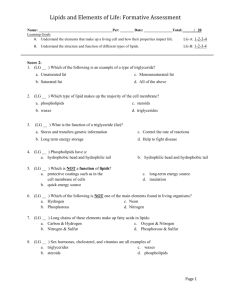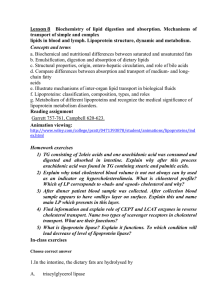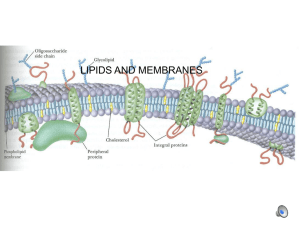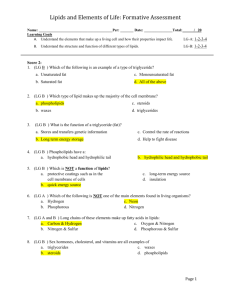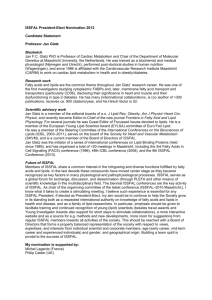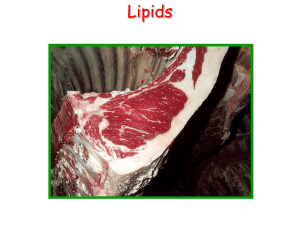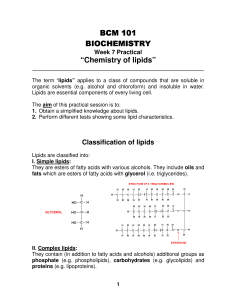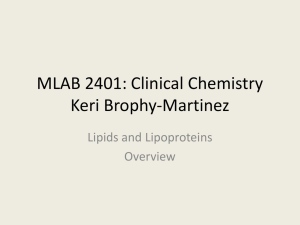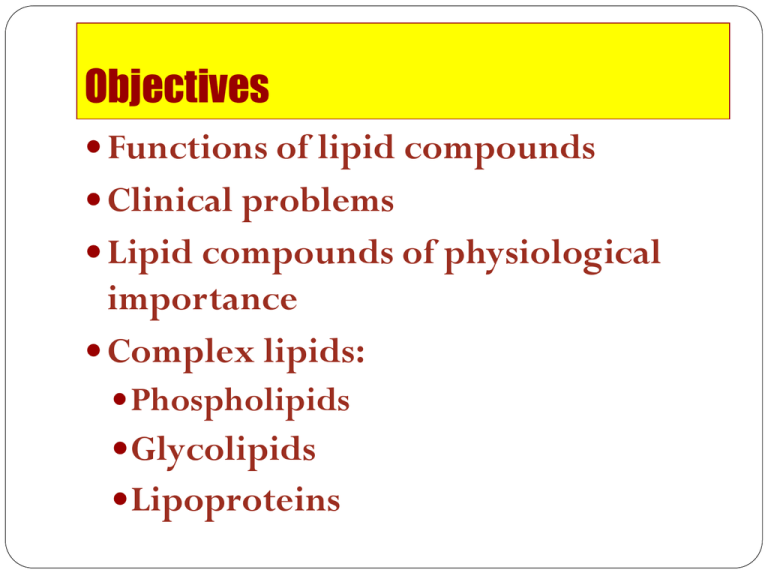
Objectives
Functions of lipid compounds
Clinical problems
Lipid compounds of physiological
importance
Complex lipids:
Phospholipids
Glycolipids
Lipoproteins
Functions of lipid compounds
Major energy source for the body
Structural component of cell membranes
Important regulatory molecules; examples:
Fat-soluble vitamins
Steroid hormones
Prostaglandins
Signaling molecules; e.g. Inositol triphosphate
(IP3)
Lipids and Related Clinical Problems
Obesity
Atherosclerosis & hypertension
Coronary heart diseases
Lipid Compounds
Heterogeneous group
Relatively water-insoluble (Ketone
bodies are the exception)
Soluble in non-polar solvents
1.
Simple Lipids:
1.
2.
3.
4.
2.
Fatty acids
Ketone bodies
Triacylglycerol
Cholesterol
Complex Lipids:
1.
2.
3.
Phospholipids
Lipoproteins
Glycolipids
Lipid Compounds:
Heterogeneous Group
Fatty Acids
Amphipathic: Both hydrophobic & hydrophilic parts
Fatty Acids
Chain length:
o Short-chain & Medium-Chain
o Long-Chain e.g., Palmitic acid 16:0
o Very long-chain e.g., Nervonic acid 24:1
Degree of saturation:
o Saturated: No double bonds
o Unsaturated:
o Mono- or poly-unsaturated
o Cis- or trans-form of double bond
Essential fatty acids
Fatty Acids
Essential Fatty Acids
1. Linoleic acid, 18:2
2. Linolenic acid, 18:3
3. The precursor of prostaglandins,
Arachidonic acid 20:4, is also
considered essential fatty acid if
linoleic acid is deficient from diet
Plasma Fatty Acids
Esterified form (~90%):
In triacylglycerol, cholesterol ester,
phospholipids (as part of lipoproteins)
Free-form (unesterified):
Transported in association with albumin
Triacylglycerols (TG)
Storage form of lipids in adipose tissue
Constitute ~ 90% of dietary lipids
Composed of glycerol plus 3 fatty acids
Transported in blood: in chylomicrons
& very low density lipoprotein (VLDL)
Ketone Bodies
1. Water-soluble
lipids
2. Increase in Diabetic
Ketoacidosis (DKA)
1. Acetone
2. Acetoacetate
3. β-Hydroxybutyrate
Phospholipids
A. Glycerophospholipids
Glycerol-containing phospholipids
1. Phosphatidylcholine (Lecithin)
e.g., Surfactant (Dipalmitoylecithin)
2. Phosphatidyl inositol (signaling molecule)
B. Sphingo-phospholipids:
Sphingosine-containing phospholipids:
e.g., sphingomyelin (Myelin sheath)
(To be discussed with CNS Block)
Phospholipids:
A. Glycerophospholipids
e.g. of members:
1. Phosphatidylcholine
(Lecithin)
e.g., Surfactant
(Dipalmitoyl lecithin)
Parent Compound
Phosphatidic acid
Cholesterol:
Structure
Overview and Functions of Cholesterol
Major Sterol of animal tissues
Component of cell membranes
Precursor for:
Bile acids & salts
Vitamin D
Steroid hormones:
Mineralocorticoids e.g., Aldosterone
Glucocorticoids, e.g., Cortisol
Sex hormones, e.g., Testosterone
Estrogen & progesterone
Abnormally high level in blood (Hypercholesterolemia):
Associated with Atherosclerosis & Coronary Artery
Disease (CAD)
Lipoprotein Structure
Protein part: Apoproteins or apolipoproteins
Abbreviations: Apo-A, B, C
Functions:
Structural and transport function
Enzymatic function
Ligands for receptors
Lipid part:
• According to the type of lipoproteins
• Different lipid components in various combinations
Lipoprotein Structure
Chylomicrons
Composition
of
Lipoproteins
Very low density
Lipoprotein (VLDL)
Low density
Lipoprotein (LDL)
High density
Lipoprotein (HDL)
Ultracentrifugation
of
Lipoproteins
Plasma Lipoproteins
Transport of Triacylglycerol (TG):
Chylomicrons:
VLDL:
TG of dietary origin
TG of endogenous synthesis
Transport of Cholesterol :
LDL:
HDL:
Mainly free cholesterol
Mainly esterified cholesterol
Take Home Message
Lipids are heterogeneous group of compounds
Lipids are relatively water-insoluble
Simple lipids:
Fatty Acid, TG, Ketone bodies, Cholesterol
Complex lipids:
e.g., Phospholipids, Lipoproteins
Lipids have important physiological functions
Lipid disorders are the basis for common human
diseases, namely obesity and atherosclerosis


